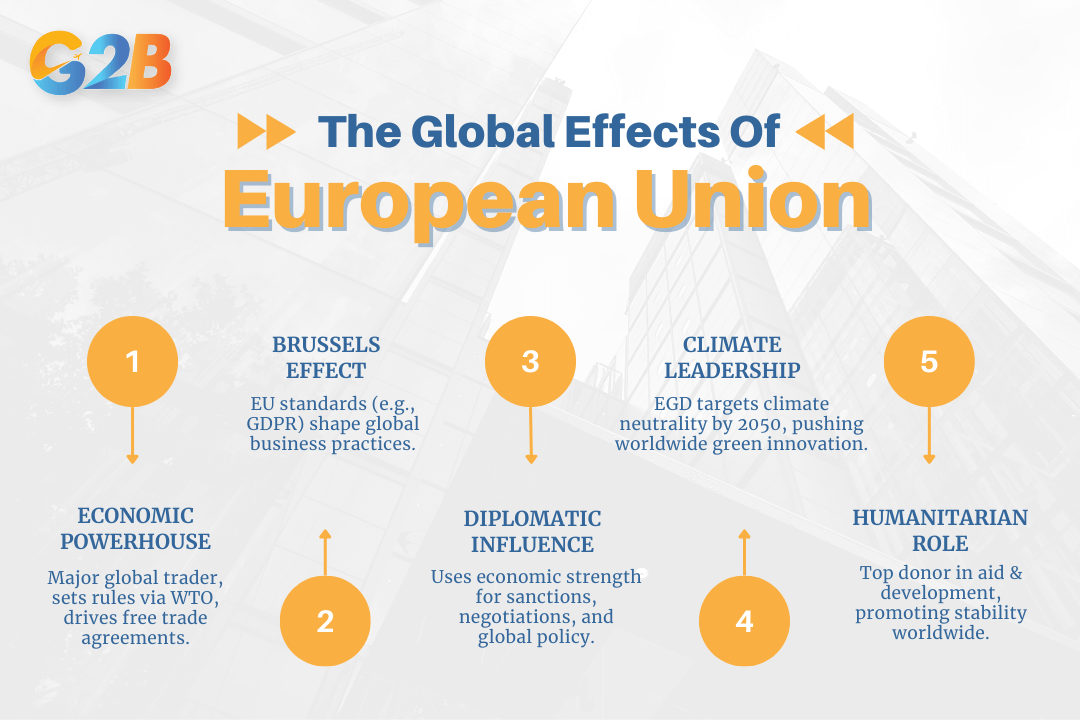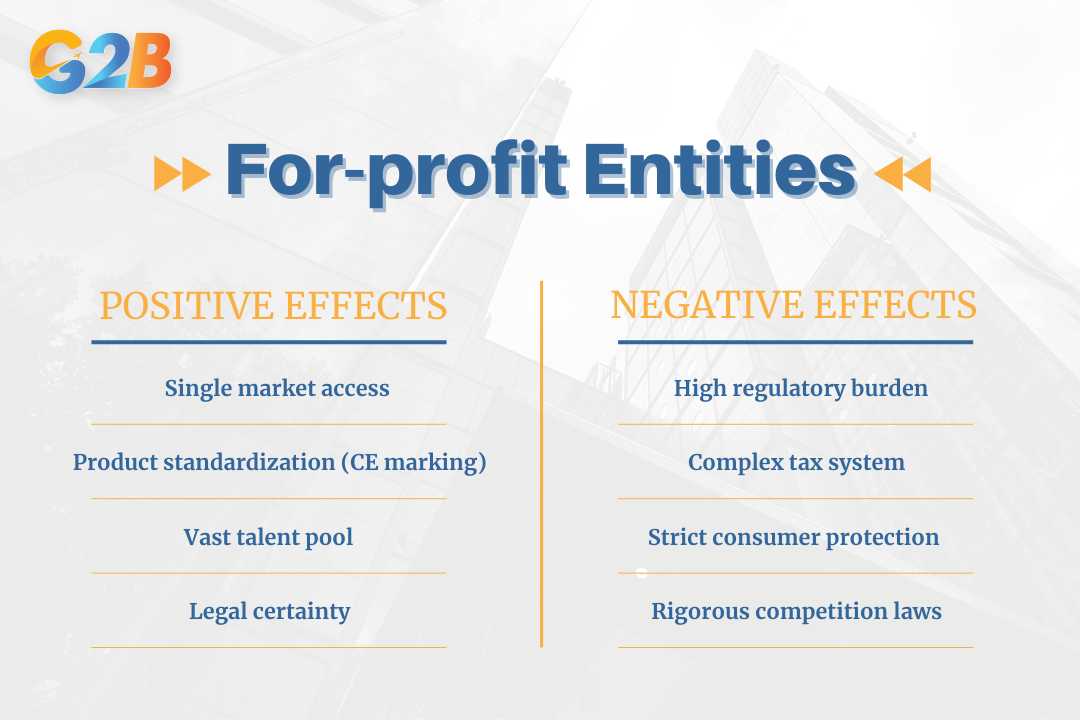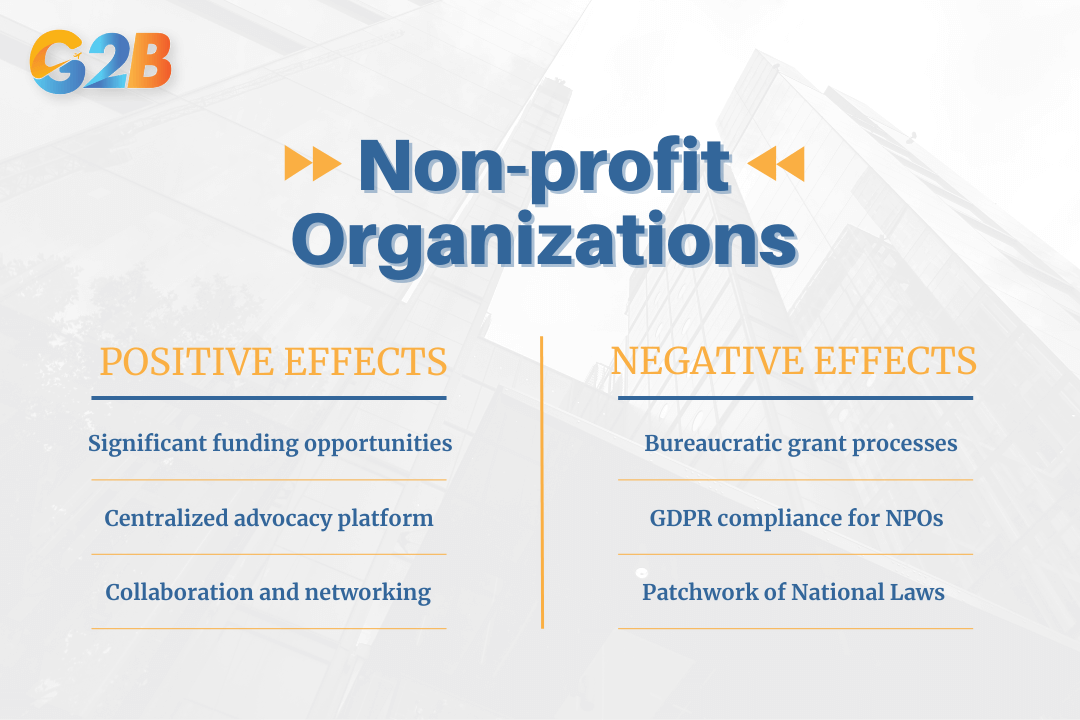The European Union (EU) is one of the most significant political and economic forces in modern history, uniting 27 member countries into a powerful single market that shapes global trade and standards. This comprehensive guide will explore the origins, history and profound effects on international business, law, and diplomacy of the European Union.
This article outlines the key aspects of the European Union (EU) to help readers gain a clearer understanding. We specialize in company formation and do not provide financial advice. For financial or legal matters, please consult a qualified expert.
What is the European Union?
The European Union (EU) is a political and economic union of 27 member states located in Europe. Its foundation is the single market, an area that allows for the free movement of goods, capital, services, and people between member states, creating an integrated economic space without being a single country politically. As one of the world's most powerful trade blocs, the EU plays a major role in global commerce and sets international standards in areas like environmental protection and democratic values.
At its core, the EU is a "unique partnership" built on the concept of "shared sovereignty." This means that member countries voluntarily cede some of their national decision-making authority to shared EU institutions in specific areas of common interest. In practical terms, this allows the EU to create binding laws in areas like trade, agriculture, and environmental protection that apply across all 27 member states. This creates a unified regulatory landscape with binding laws which can be a powerful advantage for businesses seeking consistency and scale.
The union is guided by "core objectives" that have evolved. Initially focused on securing a lasting peace after World War II, its mission has expanded to include promoting the well-being of its citizens, ensuring freedom, security, and justice, and upholding democratic values. For businesses, the EU's cornerstone achievement is "The Single Market." Established to break down internal barriers, it is built upon "four freedoms":
- Free movement of goods: Products legally produced in one member state can be sold in any other without tariffs or quantitative restrictions.
- Free movement of services: Businesses and self-employed individuals can offer their services across the EU without undue obstacles.
- Free movement of capital: Capital and investments can flow freely between member countries, facilitating cross-border investment.
- Free movement of people: EU citizens have the right to live, work, study, and retire in any other member state.
Finally, the EU acts as a formidable "Global Actor." It leverages its collective economic weight to negotiate trade agreements, set international standards, and exert diplomatic influence. Its ability to act as a unified bloc in bodies like the World Trade Organization (WTO) and to engage with other international organizations gives it a powerful voice in shaping the rules of global commerce.
A brief history of the European Union
In 1950, French Foreign Minister Robert Schuman proposed pooling French and West German coal and steel production under a common authority. This led to the signing of the Treaty of Paris in 1951, which created the European Coal and Steel Community (ECSC) among six founding nations: Belgium, France, West Germany, Italy, Luxembourg, and the Netherlands.
This initial success paved the way for the Treaty of Rome in 1957. This pivotal agreement established the European Economic Community (EEC), creating a customs union and laying the groundwork for the single market. The following decades were marked by a series of enlargements. The UK, Ireland, and Denmark joined in 1973, followed by Greece, Spain, and Portugal in the 1980s. The fall of the Berlin Wall led to a major eastward expansion in 2004, welcoming ten new countries.
The Maastricht Treaty, signed in 1992, was a watershed moment. It officially created the "European Union" as we know it today, laying out a clear path toward a single currency and establishing the "three-pillar" structure covering economic, foreign policy, and justice matters. This led directly to the introduction of the Euro, which entered circulation as banknotes and coins in 2002.
The Lisbon Treaty, which came into force in 2009, further reformed the EU's institutions to make them more democratic and efficient. It streamlined decision-making processes and gave more power to the European Parliament. Most recently, the EU faced its first major contraction with Brexit. The United Kingdom, a member since 1973, voted to leave in 2016 and formally departed in 2020, reshaping its relationship with the continent.
Which countries are in the EU?
As of 2025, the European Union comprises 27 member countries. The full list of member states is:
- Austria
- France
- Malta
- Belgium
- Germany
- Netherlands
- Bulgaria
- Greece
- Poland
- Croatia
- Hungary
- Portugal
- Cyprus
- Ireland
- Romania
- Czech Republic
- Italy
- Slovakia
- Denmark
- Latvia
- Slovenia
- Estonia
- Lithuania
- Spain
- Finland
- Luxembourg
- Sweden
The global effects of the European Union

The EU's influence extends far beyond its borders
Economic powerhouse: As one of the world's largest economies, the EU is a central player in global trade. It negotiates comprehensive free trade agreements with countries and regions around the world, opening markets and setting terms for international commerce. Its role in the WTO allows it to influence global trade rules and resolve disputes, making its policies a key factor for any international business.
The "brussels effect": This term describes the EU's unilateral ability to regulate global markets. Because access to the EU's massive consumer market is so valuable, international companies often find it more efficient to adopt EU standards for all their global operations rather than create different products for different markets. The most prominent example is the General Data Protection Regulation (GDPR). Though an EU law, its stringent data privacy and security standards have effectively become the global benchmark, forcing companies from Silicon Valley to Tokyo to adapt their practices worldwide.
Diplomatic influence: The EU leverages its economic power for diplomatic ends. It can impose sanctions on countries to encourage policy changes and plays a crucial role in international negotiations on issues ranging from nuclear proliferation to human rights. Its unified stance gives its member states a collective voice that is stronger than any single country could achieve on its own.
Leader in climate action: Through the European Green Deal, the EU has committed to becoming the first climate-neutral continent by 2050. This ambitious set of policies aims to decouple economic growth from resource use by transforming its economy, with far-reaching implications for industry, energy, transport, and agriculture. Global companies that want to do business in or with the EU must now align with these aggressive sustainability goals, driving green innovation worldwide.
Humanitarian and development aid: The EU and its member states collectively form one of the world's leading donors of humanitarian and development aid. Through programs managed by its departments for international cooperation (INTPA) and humanitarian aid (ECHO), it provides substantial funding to address crises, support long-term development, and promote stability in developing nations.
How the EU impacts global companies
For any company operating internationally, the EU is a landscape of both immense opportunity and significant regulatory challenges. Understanding this duality is critical for strategic planning.
1. For-profit entities (LLCs and Corporations)

The EU provides both opportunities and challenges for for-profit entities
Positive effects (The opportunity)
- Single market access: The most significant advantage is frictionless access to a market of over 450 million consumers. A product cleared for sale in one EU country can be sold in all 27, dramatically reducing go-to-market complexity and costs.
- Product standardization (CE marking): For many product categories, the CE marking signifies conformity with EU health, safety, and environmental protection standards. Once a manufacturer has gone through the process to affix the CE mark, the product can be sold anywhere in the European Economic Area, including the EU member states and EFTA countries (Iceland, Liechtenstein, and Norway), saving the immense cost and effort of meeting 27 different sets of national technical regulations.
- Vast talent pool: The freedom of movement for people allows companies to recruit from a highly skilled and diverse talent pool across the continent. A tech company in Dublin can seamlessly hire a software engineer from Berlin or a designer from Stockholm without the bureaucratic hurdles of traditional work visas.
- Legal certainty: The EU's legal system, built on treaties and interpreted by the Court of Justice of the European Union, provides a stable and predictable environment for business. Contracts are enforceable across borders, and intellectual property rights are protected under a unified framework, reducing risk for foreign direct investment.
Negative effects (The challenge)
- High regulatory burden: The flip side of a harmonized market is a complex and demanding regulatory environment. The GDPR is the quintessential example, imposing strict data protection rules with global reach and severe penalties for non-compliance. Companies must invest heavily in compliance programs to manage this risk.
- Complex tax system: While the EU has harmonized Value Added Tax (VAT) rules to an extent, complexities remain. For non-EU companies selling digital services to EU consumers, the VAT system requires them to register, collect, and remit VAT based on their customers' locations, adding a layer of administrative burden.
- Strict consumer protection: The EU has some of the world's strongest consumer protection laws. For instance, online retailers are required to offer a 14-day "cooling-off" period during which customers can return a product for any reason. These regulations, while beneficial for consumers, impose additional operational costs on businesses.
- Rigorous competition laws: The European Commission is a powerful antitrust regulator, and it does not hesitate to enforce competition law against major global corporations. High-profile cases against tech giants like Google and Apple have resulted in multi-billion euro fines for practices deemed to stifle competition, serving as a stark reminder of the EU's enforcement power.
The United States and the European Union share one of the world’s most influential economic partnerships, shaping global trade, investment flows, and regulatory standards. As strategic allies, they establish regulatory frameworks that often become benchmarks for international business. The EU significantly impacts global companies, requiring firms to navigate both U.S. and EU rules that affect areas such as data protection, taxation, market access, and competition policy. Within this environment, many entrepreneurs choose to register a company in Delaware, leveraging its business-friendly framework as a strategic gateway to the U.S. market while staying aligned with global standards influenced by the EU.
Explore the differences between LLCs and Corporations
2. Non-profit organizations (NPOs)

The EU offers some positive and negative effects for non-profit entities
Positive effects (The opportunity)
- Significant funding opportunities: The EU is a major source of grant funding for NPOs worldwide. Programs like Horizon Europe (for research and innovation), Erasmus+ (for education and youth), and various humanitarian aid funds provide substantial resources for organizations whose missions align with EU priorities.
- Centralized advocacy platform: For NPOs focused on policy and advocacy, Brussels is a critical hub of influence. The concentration of EU institutions provides an efficient platform for lobbying on issues from environmental protection to digital rights, allowing organizations to influence regulations that have a global impact.
- Collaboration and networking: The EU actively fosters cross-border collaboration. Many funding programs require or incentivize partnerships between organizations from different member states, creating powerful networks for sharing best practices, building capacity, and scaling impact across the continent.
Negative effects (The challenge)
- Bureaucratic grant processes: While EU funding is substantial, accessing it can be a formidable challenge. The application and reporting processes are notoriously complex, time-consuming, and bureaucratic, often requiring specialized expertise that smaller NPOs may lack, posing a significant barrier to timely and effective access to funding.
- GDPR compliance for NPOs: The compliance challenges of GDPR are not limited to for-profit companies. NPOs, which often handle sensitive data related to donors, beneficiaries, and volunteers, must also comply with its stringent requirements. The resource gap between a large corporation and a small non-profit can make achieving full compliance a significant struggle.
- Patchwork of National Laws: Despite the EU's harmonizing effect, NPOs must still navigate a patchwork of national laws. Key areas like non-profit registration, governance, and national tax regulations remain under the purview of individual member states, requiring organizations operating in multiple countries to manage diverse legal obligations.
Frequently asked questions (FAQs) about the EU
To provide clearer insights into the European Union, this part contains the answers to some of the most frequently asked questions. This section addresses common inquiries about the EU’s structure, policies, and impact, offering readers a concise reference point.
What is the difference between the EU and the Eurozone?
The Eurozone is a subset of 20 EU countries as of 2025, with Bulgaria set to join on 1 January 2026, that have adopted the euro (€) as their official currency. All 27 EU members are part of the Economic and Monetary Union (EMU), but countries must meet strict economic criteria to join the Eurozone. Seven EU countries, such as Denmark and Sweden, still use their own national currencies.
What is the Schengen Area?
The Schengen Area is a zone comprising 29 European countries that have officially abolished internal border controls. This allows for the free and unrestricted movement of people. It includes 25 of the 27 EU member states (excluding Cyprus and Ireland) as well as four non-EU countries: Iceland, Liechtenstein, Norway, and Switzerland.
How are laws made in the EU?
In the EU's main legislative procedure, the European Commission proposes new laws, and the European Parliament (representing EU citizens) and the Council of the European Union (representing the governments of the member states) must approve them. This co-decision process ensures that both the citizens' and the national governments' interests are represented in the legislative process.
What is the difference between the European Council, the Council of the EU, and the European Commission?
These are three distinct institutions:
- The European Council: Comprised of the heads of state or government of the member countries (presidents and prime ministers). It sets the EU's overall political direction and priorities but does not pass laws.
- The Council of the EU: Comprised of government ministers from each EU country. It meets in different configurations depending on the topic (e.g., agriculture ministers, finance ministers) and shares the main legislative power with the European Parliament.
- The European Commission: This is the EU's executive arm. It is responsible for proposing new legislation, implementing decisions, upholding the EU treaties, and managing the day-to-day business of the EU.
The European Union is a deeply complex and constantly evolving entity. It began as a historic peace project and has transformed into a global regulatory and economic superpower. For global businesses and organizations, the EU represents a landscape of both immense opportunity, thanks to its vast and integrated Single Market, and significant compliance challenges, driven by its rigorous and far-reaching regulatory standards.


 Delaware (USA)
Delaware (USA)  Vietnam
Vietnam  Singapore
Singapore  Hong Kong
Hong Kong  United Kingdom
United Kingdom 
